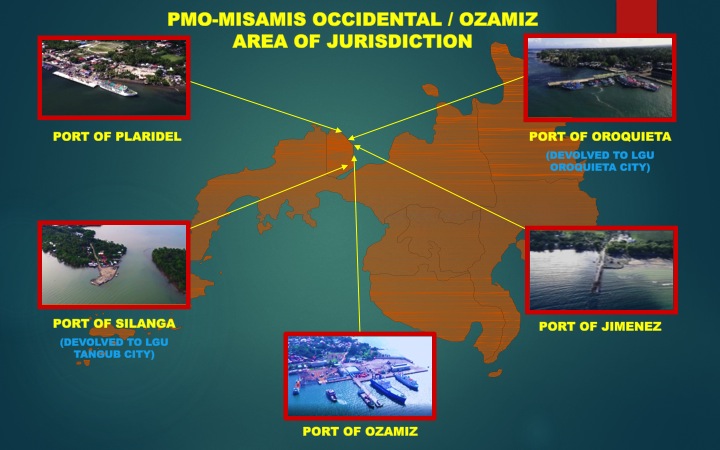The Port Management Office of Misamis Occidental/Ozamiz (PMO-MOZ) has 5 ports located in its area of jurisdiction: Port of Plaridel, Port of Oroquieta, Port of Jimenez, Port of Ozamiz, and Port of Silanga. There are 2 private ports both located in Jimenez: Third Millennium Oil Inc. (TMOI) and Chevron Philippines Inc. (CPI). The Baseport of PMO-MOZ is the Port of Ozamiz. The terminal ports are Plaridel and Jimenez.
Ozamiz City is located at the southern tip of Misamis Occidental under Region X. It is nestled at the entrance of the marine rich Panguil Bay in the North Western Mindanao with an estimated land area of 16,407 hectares. Behind it stands the 7,956 feet Mt. Malindang. It is bounded on the North by Mindanao Sea; on the East by Iligan Bay and Panguil Bay, which separates it from its twin city, Cagayan De Oro; on the South by the City of Tangub; and on the West by the Municipality of Don Victoriano. Ozamiz City straddles along the coast of Panguil Bay with its extremely rugged terrain on the interior, yet abounds with commercial activities around the coastal areas. The capital city of Misamis Occidental is Oroquieta.
The Port of Ozamiz is one of the 10 priority ports to be developed into International Standards by the Philippine Ports Authority (PPA). It is recognized as the “Gateway of Northern Mindanao” because of its strategic location, making it the entry and exit port of goods and passengers for Ozamiz City as well as for the Provinces of Misamis Occidental, Zamboanga Del Norte, Zamboanga Del Sur and Lanao Del Norte. The Port of Ozamiz caters to all sorts of goods including bottled products, meat and dairy products, lumber, as well as agricultural and industrial products. The Port of Ozamiz is IMS Certified in the facilitation processes of the Vessel Entrance and Clearance, as well as the Withdrawal and Entry of Cargoes, covering 3 standards: ISO 9001:2015 (Quality Management), ISO 14001:2015 (Environmental Management) and OHSAS 18001:2007 (Occupational Safety and Health). It is also compliant with the International Ship and Port Facility Security Code (ISPS).

The Baseport of Ozamiz. Photo Credit: PPA
The Baseport of Ozamiz has a total port area of about 51,904 sqm, and it has an expansion project in progress. From the Main Gate, one can get to the bay and river operations, and to the operational area as well. The Administration building is a 3-storey building with a floor area of 1,360 sqm that includes a function hall, conference room, guest rooms, and a mini-gymnasium. There is a Port Police Office with a total floor area of 208.5 sqm with an investigation room, and detention cells for males and females. The Port Operations Office has a total floor area of 245.76 sqm, which includes a Port Integrated Clearing Office (PICO), customer-waiting area, and a mini-conference room, in a 2-storey building. There is a new passenger terminal with 500 seating capacity for inter-island passengers, in addition to the old passenger terminal for 461 bay and river passengers. It has a transit shed covering 1,248 sqm, an open storage area of over 6,700 sqm, and a container yard of over 5,000 sqm. There is a “Well-Wishers” Facilities building that can seat 115 people.
There are also 2 reinforced concrete (R.C.) RORO Piers (Daima and Ozamis), 4 wharves, both with a draft of 7 meters deep, and a RORO ramp with a draft of 4.5 meters deep.
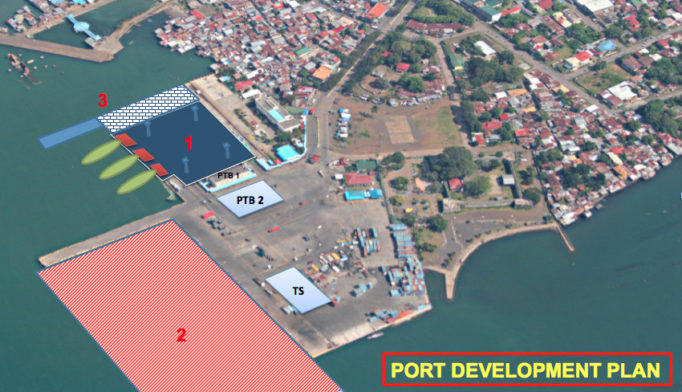
PMO-MOZ Baseport Development Plan. Photo Credit: PPA
As part of it Port Development Plan, infrastructure projects in progress include: (1) extension of R.C. Pier, construction of 3 units of flush-type RORO Ramp, and reclamation work involving 7,254 sqm; (2) dredging and excavation along the berths and maneuvering areas, with a total volume of 250K cubic meters to be dredged; (3) construction of R.C. Pier, construction of back-up area, paving of existing back-up area, and a port lighting system; (4) construction, delivery and offshore installation of aids to marine navigation system in the baseport and terminal ports; supply, construct and delivery of solar powered lighting bouys at staging area; and offshore commissioning, testing and observation of aids to marine navigation.
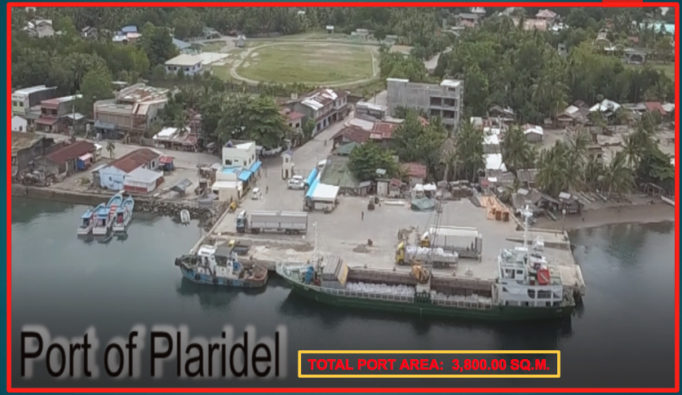
Port of Plaridel. Photo Credit: PPA
TERMINAL PORT OF PLARIDEL. Plaridel is a third income class municipality in Misamis Occidental. It became a municipality in 1907. Plaridel has a population of 38,900 people, covering a total land area of 8,000 hectares. The Port of Plaridel is located at Barangay Looc. It provides passenger and cargo services to and from: Cebu City, Tagbilaran City and Larena, Siquijor. A fish port also exists at Southern Looc adjacent to the Port of Plaridel intended for landing of commercial and local fishing boats. Electrical power is supplied through MOELCI 1, and water is supplied by Plaridel Waterworks.
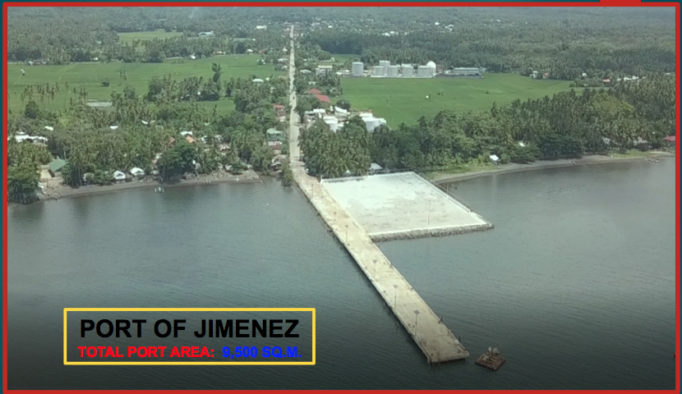
Port of Jimenez. Photo Credit: PPA
TERMINAL PORT OF JIMENEZ. Jimenez is a third class municipality located at Barangay Taboo, Jimenez, Misamis Occidental. It has population of 27,654 people. The Port of Jimenez exclusively caters to petroleum products of Filipinas Shell, Chevron Phils, and Petron whose depots are situated nearby. It also serves the incoming copra of Third Millenium Oil Mills Inc. (TMOMI) when its private port is occupied. Its sole use is for transport of copra products such as coconut oil, copra pellets and copra cakes. The Church of Saint John the Baptist, which is one of the oldest monuments and is located in one of the best-preserved colonial towns in the entire Philippines. Jimenez is a vast tract of agricultural land with a rugged interior and an opulent municipality that produces abaca and copra.
Growth in Operations. Based on operational data sourced from PPA covering 2016 to 2018, statistics show that PMO-MOZ has achieved the following compound average growth rates: (a) Shipcalls, 6%; (b) Passenger Traffic, 2.8%; (c) Container Traffic TEU, 7.7%; (d) RORO Traffic, 1.0%; and Cargo Throughput, 3.2%. Container Traffic showed the highest average growth.
Shipcalls were predominantly domestic, as with Container Traffic. But there was much higher average growth in Foreign Cargo Throughput than Domestic Cargo Throughput.
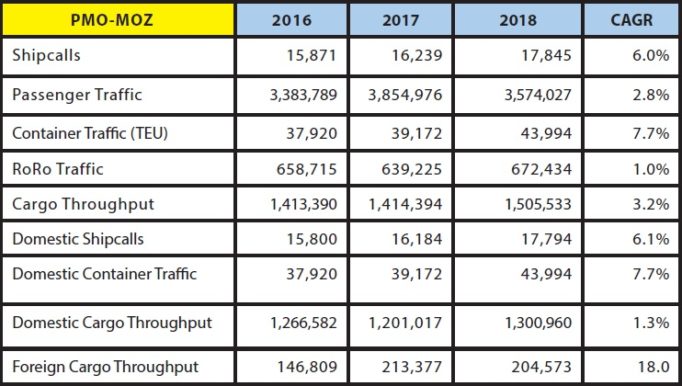
*Compound Annual Growth Rate
__________
Source of Materials:
Information and images were provided by PMO-MOZ; port statistics were obtained from PPA website.
